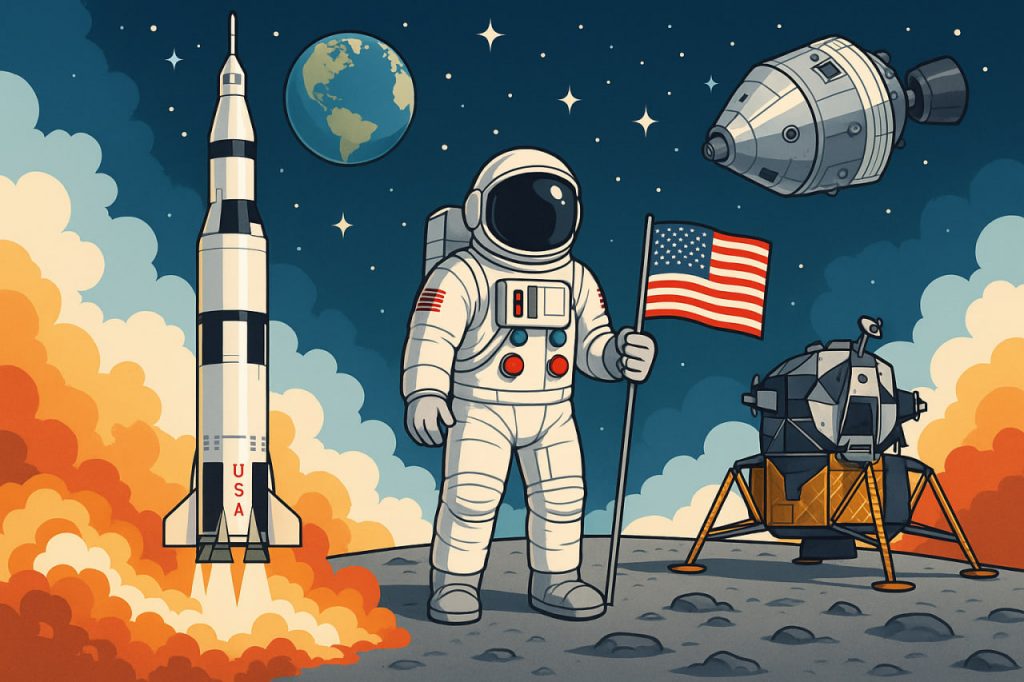The Apollo program, run by NASA between 1961 and 1972, was one of the most ambitious and historic endeavors in human history. Its goal: to land humans on the Moon and return them safely to Earth. This monumental task was driven by both scientific curiosity and geopolitical competition, particularly during the Cold War era. In the end, Apollo not only succeeded in its mission — it redefined what humanity could achieve beyond Earth.
Why Apollo Was Created
In 1961, President John F. Kennedy famously declared that the United States would send a man to the Moon before the end of the decade. This bold promise came in response to:
- The Soviet Union’s early space victories, including the launch of Sputnik and the first human in space, Yuri Gagarin
- The desire to showcase American technological superiority
- The belief that space was the new frontier for exploration and national prestige
Thus, Project Apollo was born — not just as a scientific mission, but as a symbol of political will and innovation.
Major Apollo Missions
Here are the most significant missions that shaped the Apollo legacy:
- Apollo 1 (1967): Ended tragically when a fire during a test killed three astronauts — a critical wake-up call that led to major safety overhauls.
- Apollo 7 (1968): The first successful crewed Apollo mission, testing systems in Earth orbit.
- Apollo 8 (1968): First humans to orbit the Moon, capturing the famous “Earthrise” photo.
- Apollo 11 (1969): The historic first Moon landing. Neil Armstrong and Buzz Aldrin walked on the lunar surface, while Michael Collins orbited above.
- Apollo 13 (1970): Suffered a near-fatal explosion en route to the Moon. Thanks to heroic efforts, the crew returned safely — “Failure is not an option” became a legacy phrase.
- Apollo 17 (1972): The last mission of the program and the final time humans walked on the Moon to date.
Technological Achievements
The Apollo program produced groundbreaking technology, including:
- The Saturn V rocket, still the most powerful rocket ever flown
- The Lunar Module, designed for landing and takeoff on the Moon
- Portable life support systems, space suits, and communication tools
- Advanced computers and navigation systems for space travel
Many of these innovations laid the foundation for modern spacecraft design and space science instruments.
Scientific Discoveries
Apollo missions brought back over 380 kilograms of lunar rocks and soil, revealing:
- The Moon’s surface is volcanic and ancient, not Earth-like
- Evidence about the Moon’s formation likely being the result of a giant impact
- Unique minerals and isotopes not found on Earth
- A clearer understanding of solar wind and cosmic rays through surface experiments
Cultural and Political Impact
The Apollo landings became a global spectacle, uniting millions in awe and inspiration. The phrase “One small step for man, one giant leap for mankind” became iconic. Apollo proved that international collaboration, science, and determination could achieve the impossible.
However, the program also faced criticism for its cost — around $25 billion USD (over $150 billion in today’s money). After the public interest waned, funding decreased, and the final planned missions were canceled.
Legacy and What Came Next
Even decades later, Apollo continues to influence space exploration:
- Modern missions (like NASA’s Artemis program) are directly inspired by Apollo’s structure.
- The Moon landing remains one of the most documented and analyzed events in human history.
- Apollo astronauts became icons and inspired generations of scientists and engineers.
- The program showed that space exploration is not just about science — it’s also about vision, courage, and global impact.
Glossary
- Saturn V: The giant rocket that launched Apollo missions into space.
- Lunar Module (LM): The spacecraft used to land on and return from the Moon’s surface.
- Apollo 11: The mission during which the first humans walked on the Moon.
- Artemis Program: NASA’s current plan to return humans to the Moon.
- Cold War: A political rivalry between the US and the Soviet Union that fueled the space race.


